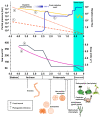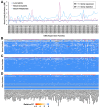Chronic Ionizing Radiation of Plants: An Evolutionary Factor from Direct Damage to Non-Target Effects
- PMID: 36904038
- PMCID: PMC10005729
- DOI: 10.3390/plants12051178
Chronic Ionizing Radiation of Plants: An Evolutionary Factor from Direct Damage to Non-Target Effects
Abstract
In present times, the levels of ionizing radiation (IR) on the surface of Earth are relatively low, posing no high challenges for the survival of contemporary life forms. IR derives from natural sources and naturally occurring radioactive materials (NORM), the nuclear industry, medical applications, and as a result of radiation disasters or nuclear tests. In the current review, we discuss modern sources of radioactivity, its direct and indirect effects on different plant species, and the scope of the radiation protection of plants. We present an overview of the molecular mechanisms of radiation responses in plants, which leads to a tempting conjecture of the evolutionary role of IR as a limiting factor for land colonization and plant diversification rates. The hypothesis-driven analysis of available plant genomic data suggests an overall DNA repair gene families' depletion in land plants compared to ancestral groups, which overlaps with a decrease in levels of radiation exposure on the surface of Earth millions of years ago. The potential contribution of chronic IR as an evolutionary factor in combination with other environmental factors is discussed.
Keywords: DNA damage; acute exposure; antioxidants; chronic exposure; hormesis; nuclear accident; plant evolution; plant terrestrialization; repair pathway; trade-off.
Conflict of interest statement
The authors declare no conflict of interest. The funders had no role in the design of the study; in the collection, analyses, or interpretation of data; in the writing of the manuscript; or in the decision to publish the results.
Figures




Similar articles
-
Adaptation to ionizing radiation of higher plants: From environmental radioactivity to chernobyl disaster.J Environ Radioact. 2020 Oct;222:106375. doi: 10.1016/j.jenvrad.2020.106375. Epub 2020 Aug 10. J Environ Radioact. 2020. PMID: 32791372 Review.
-
Ionizing Radiation, Higher Plants, and Radioprotection: From Acute High Doses to Chronic Low Doses.Front Plant Sci. 2018 Jun 26;9:847. doi: 10.3389/fpls.2018.00847. eCollection 2018. Front Plant Sci. 2018. PMID: 29997637 Free PMC article. Review.
-
Genotoxic and reprotoxic effects of tritium and external gamma irradiation on aquatic animals.Rev Environ Contam Toxicol. 2012;220:67-103. doi: 10.1007/978-1-4614-3414-6_3. Rev Environ Contam Toxicol. 2012. PMID: 22610297 Review.
-
Hormesis and radiation safety norms: Comments for an update.Hum Exp Toxicol. 2018 Nov;37(11):1233-1243. doi: 10.1177/0960327118765332. Epub 2018 Apr 2. Hum Exp Toxicol. 2018. PMID: 29607734
-
Ionizing radiation manifesting DNA damage response in plants: An overview of DNA damage signaling and repair mechanisms in plants.Plant Sci. 2019 Jan;278:44-53. doi: 10.1016/j.plantsci.2018.10.013. Epub 2018 Oct 24. Plant Sci. 2019. PMID: 30471728 Review.
Cited by
-
Comparative Analysis of the Effect of Gamma-, Electron, and Proton Irradiation on Transcriptomic Profile of Hordeum vulgare L. Seedlings: In Search for Molecular Contributors to Abiotic Stress Resilience.Plants (Basel). 2024 Jan 23;13(3):342. doi: 10.3390/plants13030342. Plants (Basel). 2024. PMID: 38337875 Free PMC article.
-
Multi-Omics Analysis of Vicia cracca Responses to Chronic Radiation Exposure in the Chernobyl Exclusion Zone.Plants (Basel). 2023 Jun 14;12(12):2318. doi: 10.3390/plants12122318. Plants (Basel). 2023. PMID: 37375943 Free PMC article.
-
Soil Microbes and Plant-Associated Microbes in Response to Radioactive Pollution May Indirectly Affect Plants and Insect Herbivores: Evidence for Indirect Field Effects from Chernobyl and Fukushima.Microorganisms. 2024 Feb 10;12(2):364. doi: 10.3390/microorganisms12020364. Microorganisms. 2024. PMID: 38399767 Free PMC article. Review.
-
Chronic low dose 90Sr contamination in Lemna minor: from transcriptional dynamics of epigenetic regulators to population level effects.Front Plant Sci. 2025 Jun 26;16:1605017. doi: 10.3389/fpls.2025.1605017. eCollection 2025. Front Plant Sci. 2025. PMID: 40641864 Free PMC article.
-
Laser fragmentation of amorphous and crystalline selenium of various morphologies and assessment of their antioxidant and protection properties.Front Chem. 2024 Aug 9;12:1459477. doi: 10.3389/fchem.2024.1459477. eCollection 2024. Front Chem. 2024. PMID: 39185370 Free PMC article.
References
-
- ICRP . Environmental Protection—The Concept and Use of Reference Animals and Plants. Volume 38 ICRP Publication; Ottawa, ON, Canada: 2008. Annals of the ICRP. - PubMed
-
- Shu Q.Y., Forster B.P., Nakagawa H., Nakagawa H. Plant Mutation Breeding and Biotechnology. FAO/IAEA; Vienna, Austria: CABI; Wallingford, UK: 2012.
Publication types
LinkOut - more resources
Full Text Sources

